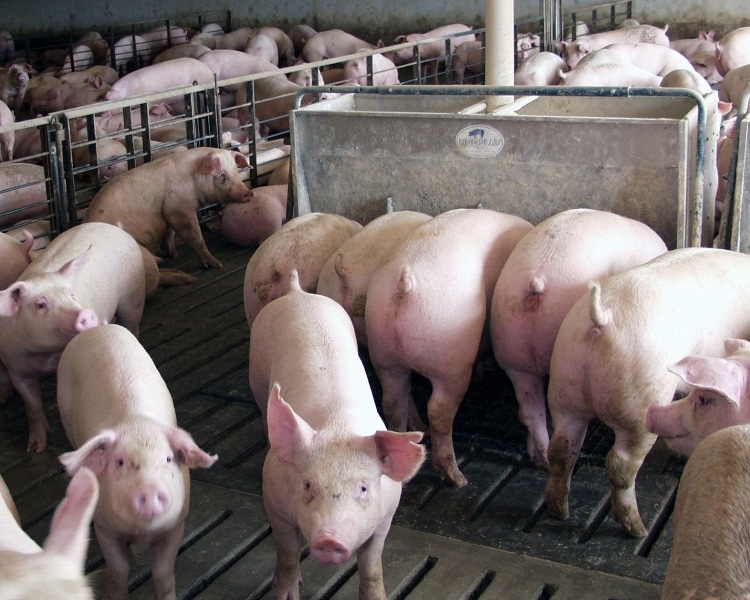Kansas State University researchers found withdrawing a high neutral detergent fiber (NDF) diets containing distiller's dried grains with solubles (DDGS) and wheat midds before market can improve feed/gain, carcass yield and jowl iodine value in pigs.
February 15, 2012

Wheat middlings (midds) and dried distiller’s grains with solubles (DDGS) are often used as alternatives to corn and soybean meal in swine diets. While these ingredients can lower feed costs, they can negatively affect performance, carcass yield and fat quality.
Soft carcass fat with a high iodine value (IV) is consistently seen in pigs fed high levels of DDGS. While reducing DDGS levels prior to marketing lowers IV and improves yield, the timing and level of reduction needs a closer look.
In a 90-day trial, researchers tracked the effects of decreasing or fully withdrawing neutral detergent fiber (NDF) provided by wheat midds and DDGS. In the trial, 264 pigs were allocated four barrows and four gilts per pen or three barrows and four gilts per pen, randomly allotted by weight to one of six dietary treatments, with six replications per treatment.
Treatments focused on withdrawal time (23 or 47 days prior to slaughter) and a dietary fiber level (14.2% or 9.3% NDF). A positive control diet containing no DDGS or midds (9.3% NDF) and a negative control diet containing 30% DDGS and 19% midds (19% NDF) were fed. All diets were corn-soybean meal-based, fed in four phases and in meal form.
Diet samples were collected at manufacturing with composite samples analyzed. Samples were also collected from each feeder during each phase and combined for a composite sample, by treatment, to measure bulk density (lb./bu.).
Adding dietary NDF dramatically decreased diet bulk density. Withdrawal treatments did not affect average daily gain, although pigs switched from the high-fiber diets on Day 43 grew faster to Day 67.
Average daily feed intake was reduced and feed/gain improved as withdrawal periods increased. Withdrawing high-fiber diets for only 23 days before marketing did not alter average daily feed intake or feed/gain.
Withdrawing the high-NDF diet improved carcass yield with a greater response when the low-NDF diet was fed vs. medium-NDF diet during the withdrawal period. Increasing withdrawal time from 23 to 47 days did not improve yield further.
Jowl fat IV decreased as withdrawal time increased and was lower for pigs fed the low-NDF diet vs. medium-NDF diet. Increasing withdrawal time from 23 to 47 days further reduced jowl IV. Feeding the low-NDF diets longer increased backfat depth and decreased lean percentage.
Overall, researchers found that withdrawing the high-NDF diet containing DDGS and midds before market can improve feed/gain, carcass yield and jowl IV and reduce large intestine weight.
Researchers: Matt Asmus; Joel DeRouchey; Jim Nelssen; Mike Tokach; Steve Dritz, DVM; Robert Goodband and Terry Houser, Kansas State University. Contact Asmus by phone at (785) 532-1270 or email [email protected].
You May Also Like



